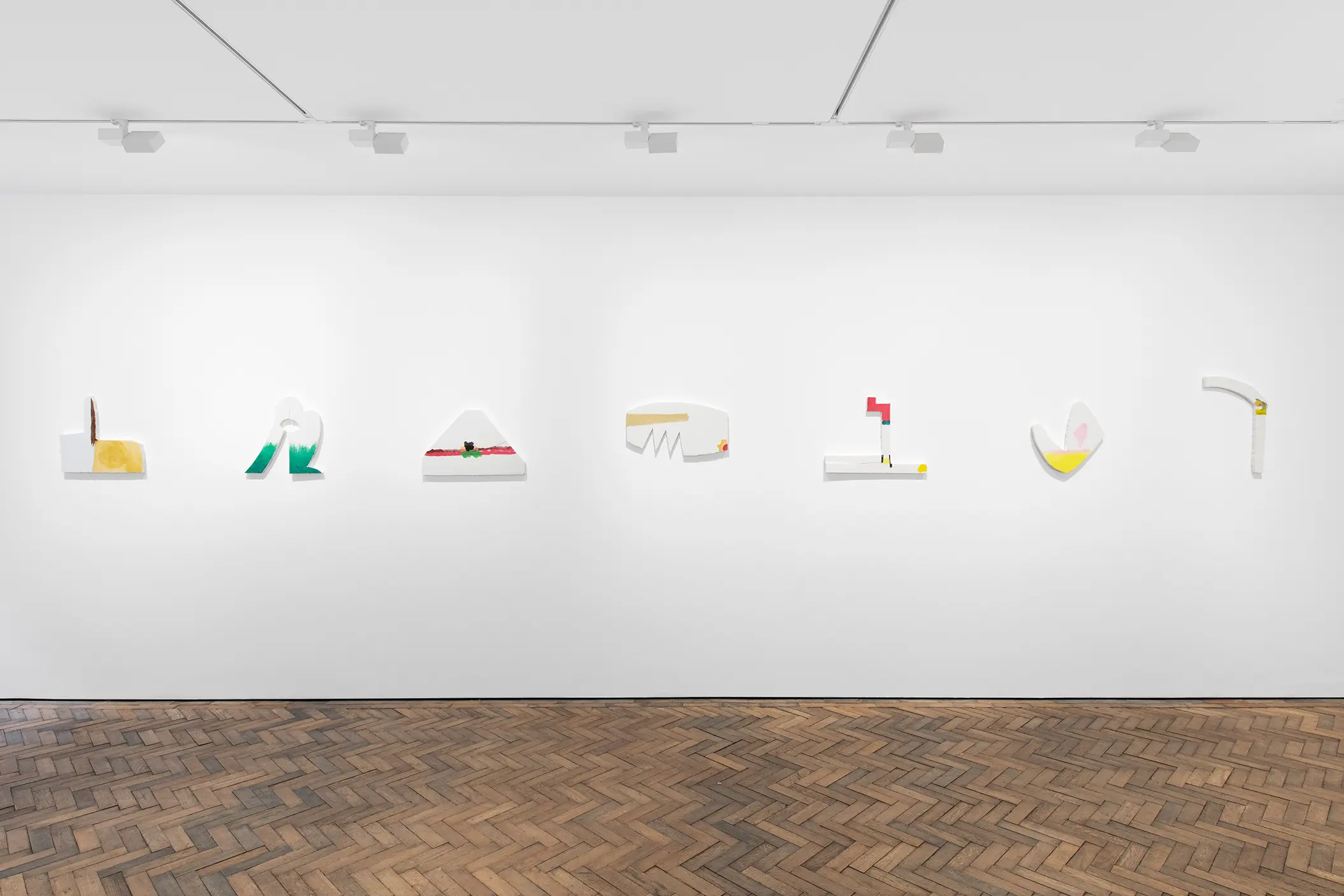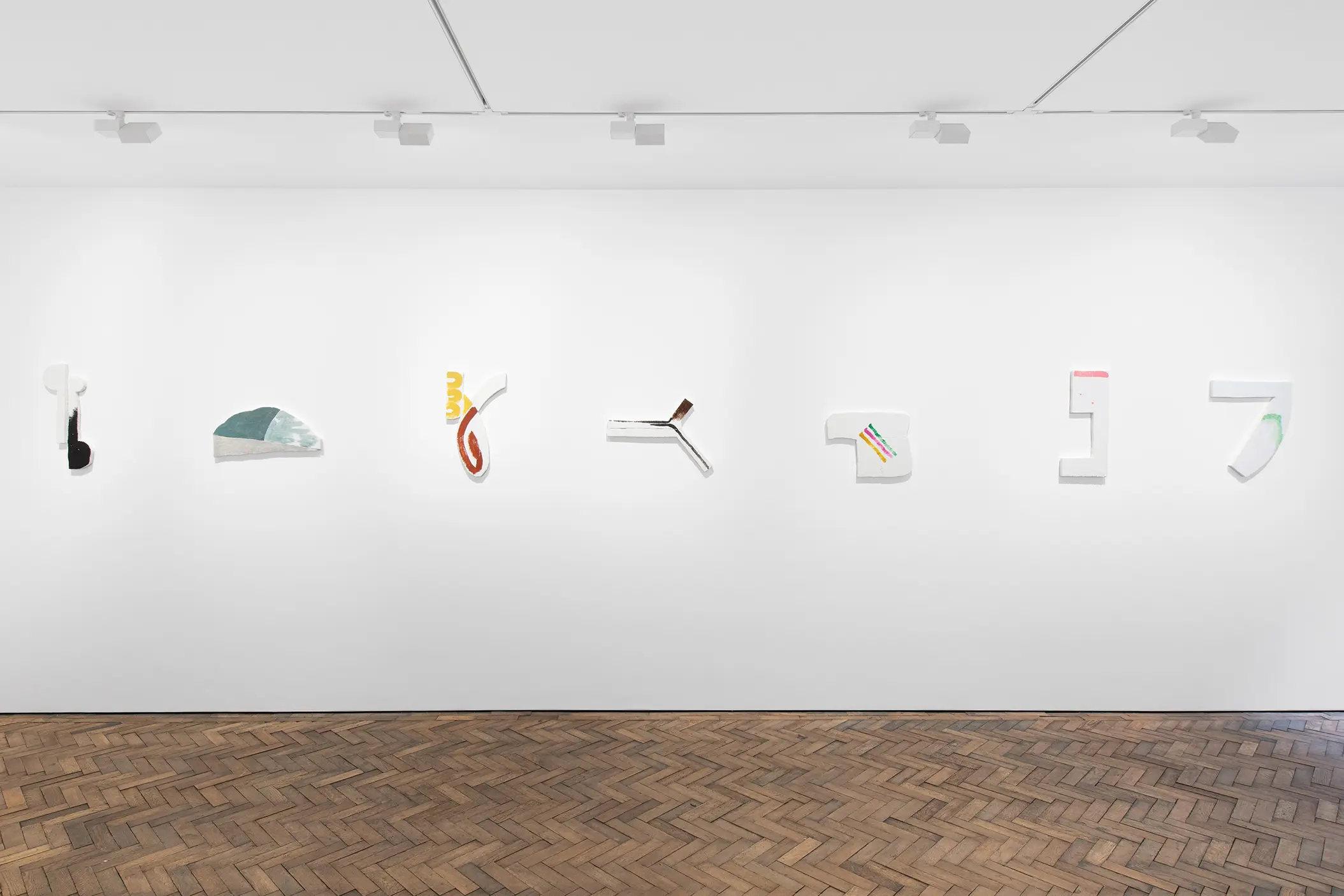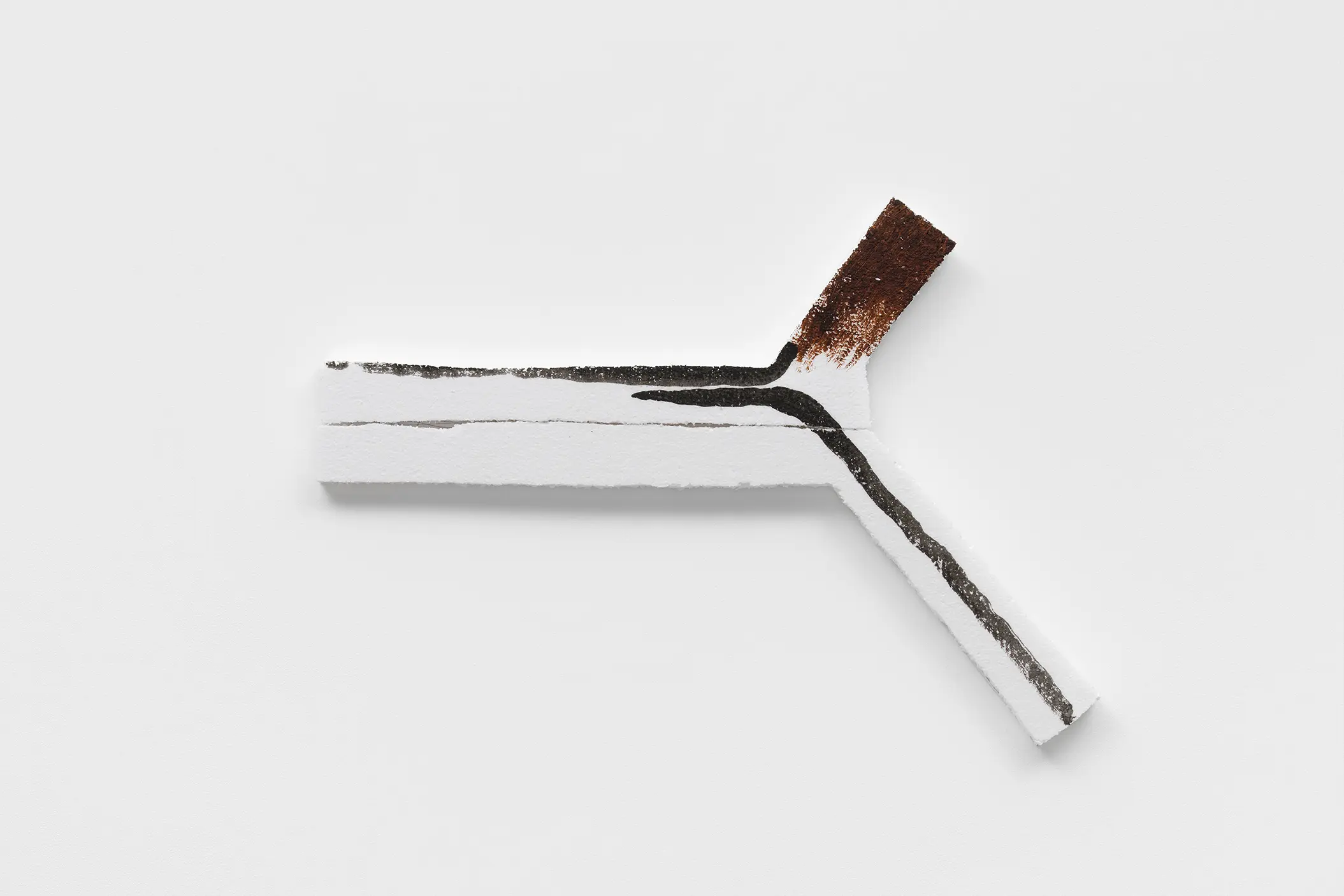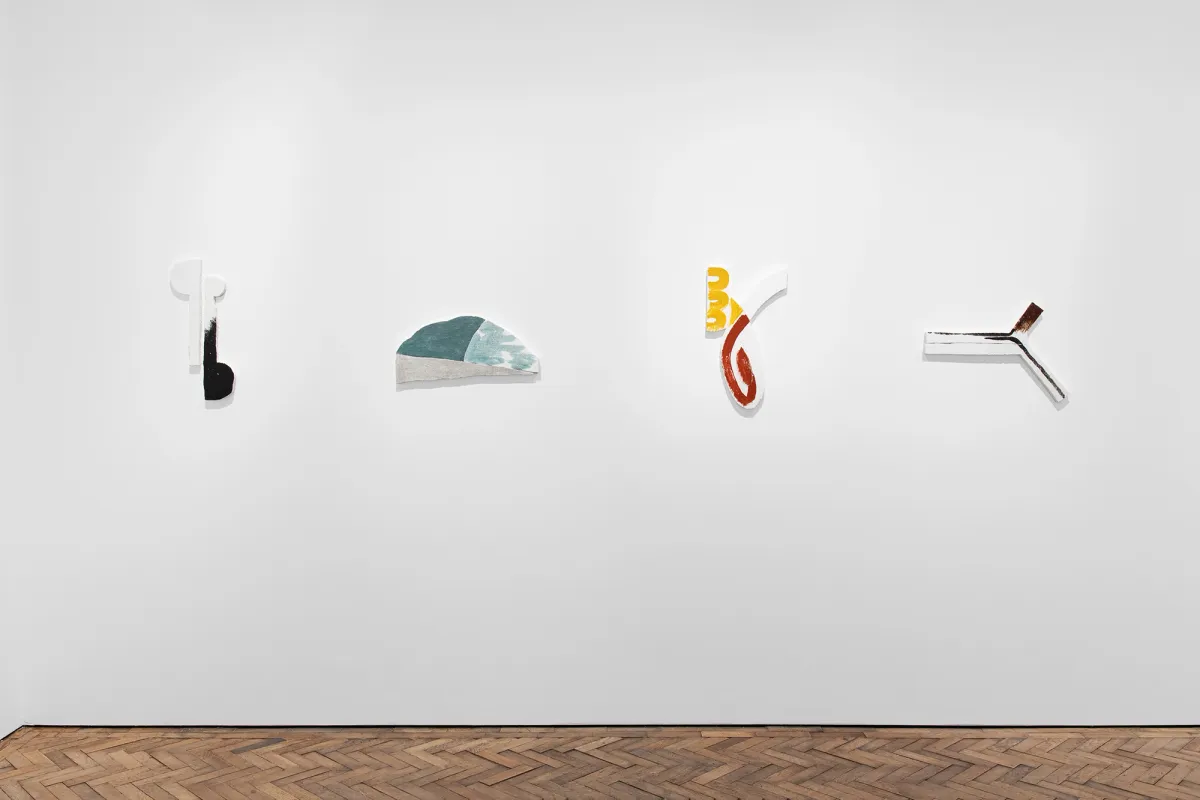We use cookies and other technologies to personalize your experience and collect analytics.
18 x 24
Richard Tuttle
Richard Tuttle
18 x 24
26 April – 20 May 2023
Modern Art is pleased to announce the second of two consecutive exhibitions by Richard Tuttle, together forming a large-scale solo presentation of both new and historical work, marking Tuttle’s sixth showing with Modern Art. Following the presentation of Tuttle’s historical installation, Village V, Modern Art’s second exhibition at its Bury Street gallery contains a group of new wall-based works made by Tuttle in his New Mexico studio over the past year.

Each beginning as a word drawing on a piece of 18 x 24 inch paper, these drawings are then translated into sculptural and painterly forms. Some remain almost entirely as abstract while others edge closer to glyphs-like forms, invoking the graphics of symbols, letters or images. Made from polystyrene foam board and painted with a light and lyrical brush, these works are then hung directly over the original word drawings, leaving their antecedent linguistic or graphic content concealed. Like much of Tuttle’s oeuvre, 18 x 24 originates from a strict methodological process that is enlivened through Tuttle’s intuition and lightness of touch; the unconscious impulses permitted entry into a finely tuned system.

Tuttle describes these works, and the methodology behind them, as continuing a larger project of examining the nexus between verbal and visual worlds. Grouped together, with their idiosyncratic shapes and playful colours — reminiscent of Tuttle’s early works – 18 x 24 creates a space of reverie, where the pleasure of abstract colour, texture and shape interact with the symbolic order of language. As such, hung in a single line across the walls of the space, these new works invite a kind of close, linear looking from left to right (or right to left), while moving around the gallery, as though to evoke the eye’s movements across the lines of a page.

Born in 1941, Richard Tuttle currently lives and works in Abiquiu, New Mexico, New York City and Mount Desert, Maine. He is considered to be one of the leading figures of the Post-Minimalist tradition. Through his iconic language of modesty and idiosyncrasy, Tuttle’s work has invented a poetics of space and materiality influencing subsequent generations in untold ways. Since his first exhibition in 1965 at Betty Parsons Gallery in New York, his work has been the subject of more than two hundred solo exhibitions. His work was included in the Venice Biennale in 1976, 1997 and 2001, Documenta in 1972, 1977 and 1982, and the Whitney Biennial of American Art in 1977, 1987 and 2000.

Press release

Modern Art is pleased to announce the second of two consecutive exhibitions by Richard Tuttle, together forming a large-scale solo presentation of both new and historical work, marking Tuttle’s sixth showing with Modern Art.
Following the presentation of Tuttle’s historical installation, Village V, Modern Art’s second exhibition at its Bury Street gallery contains a group of new wall-based works made by Tuttle in his New Mexico studio over the past year. Each beginning as a word drawing on a piece of 18 x 24 inch paper, these drawings are then translated into sculptural and painterly forms. Some remain almost entirely as abstract while others edge closer to glyphs-like forms, invoking the graphics of symbols, letters or images. Made from polystyrene foam board and painted with a light and lyrical brush, these works are then hung directly over the original word drawings, leaving their antecedent linguistic or graphic content concealed. Like much of Tuttle’s oeuvre, 18 x 24 originates from a strict methodological process that is enlivened through Tuttle’s intuition and lightness of touch; the unconscious impulses permitted entry into a finely tuned system. Tuttle describes these works, and the methodology behind them, as continuing a larger project of examining the nexus between verbal and visual worlds. Grouped together, with their idiosyncratic shapes and playful colours - reminiscent of Tuttle’s early works – 18 x 24 creates a space of reverie, where the pleasure of abstract colour, texture and shape interact with the symbolic order of language. As such, hung in a single line across the walls of the space, these new works invite a kind of close, linear looking from left to right (or right to left), while moving around the gallery, as though to evoke the eye’s movements across the lines of a page.
Born in 1941, Richard Tuttle currently lives and works in Abiquiu, New Mexico, New York City and Mount Desert, Maine. He is considered to be one of the leading figures of the Post-Minimalist tradition. Through his iconic language of modesty and idiosyncrasy, Tuttle’s work has invented a poetics of space and materiality influencing subsequent generations in untold ways. Since his first exhibition in 1965 at Betty Parsons Gallery in New York, his work has been the subject of more than two hundred solo exhibitions. His work was included in the Venice Biennale in 1976, 1997 and 2001, Documenta in 1972, 1977 and 1982, and the Whitney Biennial of American Art in 1977, 1987 and 2000.
In London in 2014, Richard Tuttle undertook the Turbine Hall commission for Tate Modern, I Don’t Know . The Weave of Textile Language, which coincided with the retrospective solo exhibition The Weave of Textile Language at the Whitechapel Gallery. The survey exhibition The Art of Richard Tuttle was organised by the San Francisco Museum of Modern Art, USA, in 2005, from where it travelled to the Whitney Museum of American Art, New York, USA, Des Moines Art Center, Iowa, USA, Dallas Museum of Art, USA, Museum of Contemporary Art, Chicago, USA, and Museum of Contemporary Art, Los Angeles, USA, through 2007. Tuttle’s work can be found in over 45 major public collections all over the world.
Other recent solo exhibitions have taken place at such institutions as Bard Graduate Center, New York, NY, USA (2022); Mu.ZEE, Oostende, Belgium (2017); Proyecto amil and Museo de Arte de Lima (mali), Lima, Peru (2016); The Critical Edge, The Metropolitan Museum of Art, New York, NY, USA (2016); Kunstmuseum Winterthur, Winterthur, Switzerland (2016); Pulitzer Arts Foundation, St Louis, MO, USA (2015); Fabric Workshop and Museum, Philadelphia, USA (2015); Bergen Kunsthall, Norway (2012); Pinakothek der Moderne, Munich, Germany (2012); Kunstverein Munich, Germany (2012); Dublin City Gallery, The Hugh Lane, Ireland (2010 – 2011); Kunsthaus Zug, Switzerland (2008); Musée d’Art Contemporain, Bordeaux, France (2005); Drawing Center, New York, USA, travelled to Aspen Art Museum, Aspen, USA (2004 – 2006).